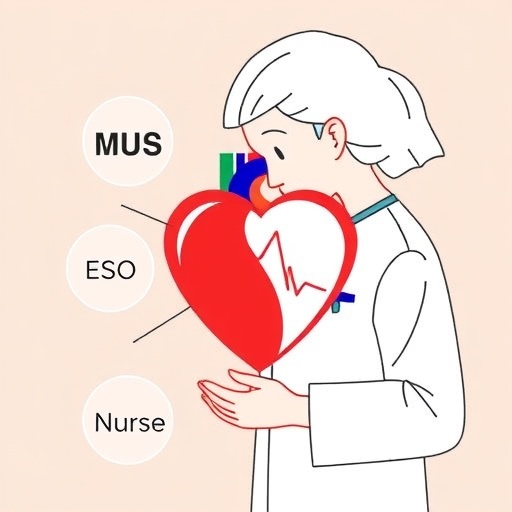In a groundbreaking advancement in the field of molecular medicine, researchers have unveiled a pioneering approach that leverages circular RNA (circRNA) to deliver protein replacement therapy, demonstrating profound therapeutic effects in a murine model of osteoarthritis. This study, published in Nature Communications, marks a significant leap toward novel treatment strategies that transcend traditional gene therapy and protein supplementation methods, potentially ushering in a new era of precision medicine for degenerative joint diseases.
Osteoarthritis, the most common form of arthritis affecting millions worldwide, is characterized by the progressive degradation of cartilage and joint tissues, leading to pain, stiffness, and impaired mobility. Conventional treatments primarily aim to manage symptoms rather than to halt or reverse disease progression. The advent of circRNA-based therapeutics offers a tantalizing avenue by enabling endogenous protein expression in affected tissues, thereby directly addressing the molecular deficiencies underlying the pathology.
The research team, spearheaded by Suo, Li, Tan, and colleagues, designed an innovative circRNA construct encoding a therapeutic protein critical for cartilage homeostasis. Their approach capitalizes on the intrinsic stability and translational capacity of circRNAs, which differ fundamentally from linear messenger RNAs due to their covalently closed loop structure, imparting resistance to exonucleases and enhancing persistence within cells. This stability translates into prolonged protein expression, a coveted feature for therapeutic efficacy.
To assess the translational potential of their circRNA platform, the scientists employed a well-established osteoarthritis model in male mice. By intra-articularly delivering the circRNA formulation directly into the affected joints, they ensured localized expression, minimizing off-target effects and systemic exposure. Advanced delivery vectors encapsulated in lipid nanoparticles likely facilitated efficient cellular uptake and circRNA release, although specifics were methodically optimized to maximize bioavailability and minimize immunogenicity.
The results were remarkable. Mice treated with circRNA-based replacement therapy exhibited significant attenuation of cartilage degradation, reduced inflammatory markers, and restoration of joint function compared to untreated controls. Histological analyses confirmed the preservation of cartilage architecture, and behavioral assays underscored improvements in mobility and pain-related responses. These outcomes testify to the potential of circRNA therapeutics to not only satiate protein deficits but also modulate the intricate cellular milieu that governs tissue repair and inflammation.
Beyond the immediate therapeutic benefits, this study illuminates the advantages of circRNA over other nucleic acid-based modalities. Unlike linear mRNAs used in various vaccines and experimental therapies, circRNAs evade rapid degradation and possess an inherent translational advantage, which could translate into lower dosing requirements and reduced side effect profiles. Their biocompatibility and scalability further enhance their clinical appeal, fostering enthusiasm for extensive preclinical and eventual clinical evaluations.
One of the compelling facets of this research is the team’s detailed mechanistic exploration. By employing transcriptomic and proteomic analyses, they demonstrated that the circRNA-mediated protein replacement reinstated key signaling pathways disrupted in osteoarthritic joints. These pathways include anabolic signals promoting cartilage synthesis and catabolic cascades associated with matrix degradation. The capacity of circRNA therapeutics to reprogram diseased tissue environments by restoring molecular balance underscores their versatility.
While the immediate focus was on osteoarthritis, the implications of this work extend far beyond degenerative joint diseases. Protein replacement therapy via circRNA could revolutionize treatments for a swath of disorders typified by protein insufficiencies, such as certain enzyme deficiencies, neurodegenerative diseases, and muscular dystrophies. The modularity of circRNA design facilitates the customization of therapeutic proteins, enabling tailored interventions for a diversity of clinical phenotypes.
Despite the promising outcomes, the authors acknowledged several challenges that must be addressed before circRNA therapies can reach clinical settings. Immunogenicity remains a critical consideration, given that exogenous RNA species may elicit innate immune responses. The study carefully evaluated potential cytotoxic and inflammatory effects, finding minimal adverse reactions, yet long-term safety profiles necessitate comprehensive assessment. Additionally, translating dosage paradigms from murine models to humans requires nuanced pharmacokinetic and pharmacodynamic studies.
The delivery vehicles used to ferry circRNAs into tissues also warrant optimization. Lipid nanoparticles showed efficacy in this experimental context, but their biodistribution, metabolism, and clearance must be finely controlled to avoid unintended accumulation or off-target effects. Emerging nanotechnologies and surface modifications may enhance specificity and cellular targeting, broadening the therapeutic index of circRNA interventions.
As the field advances, the integration of circRNA platforms with regenerative medicine and biomaterials holds exciting promise. For instance, combining circRNA therapeutics with hydrogel scaffolds or injectable biomatrices could offer sustained localized delivery, augmenting cartilage regeneration and functional restoration. This multidisciplinary convergence stands to amplify therapeutic durability and patient outcomes.
Furthermore, the scalability and manufacturing ease of circRNA vaccines and therapies have been bolstered by recent biotechnological breakthroughs. The robust in vitro transcription protocols and enzymatic circularization methods now permit high-fidelity synthesis of clinical-grade circRNAs, compounding the practicality of rapid therapeutic development, especially in response to emergent diseases or individualized medicine paradigms.
The profound implications of this study resonate across the biomedical landscape. By harnessing the unique properties of circRNAs for protein replacement, the research embodies the paradigm shift toward RNA therapeutics extending beyond transient gene knockdown or vaccine platforms, venturing into durable protein restoration with therapeutic impact. This capacity may recalibrate treatment frameworks for chronic diseases, moving from symptomatic management to molecular correction.
As more research groups engage with circRNA biology, understanding their interactions with cellular machinery, including ribosomes, nucleases, and immune sensors, will refine therapeutic design. The interplay between circRNA modifications, secondary structures, and translation efficiency presents fertile ground for innovation, aiming to optimize expression while mitigating risks.
In summary, Suo and colleagues have charted a transformative trajectory for osteoarthritis treatment through circRNA-based protein replacement therapy. Their meticulous experimentation substantiates the viability of this approach in mitigating joint degeneration and functional decline, hinting at broader applications for circRNA therapeutics. As clinical translation progresses, these insights offer hope for millions affected by osteoarthritis and related disorders, heralding a new chapter in RNA medicine.
This research not only enhances our molecular toolkit but also exemplifies the synergy between fundamental RNA biology and clinical ambition, inspiring continued exploration into circRNA’s therapeutic potential. The journey from bench to bedside may be complex, yet the promise of durable, target-specific, and minimally invasive treatments invigorates the quest for next-generation therapies grounded in RNA innovation.
Subject of Research: Circular RNA-based protein replacement therapy for osteoarthritis treatment
Article Title: Circular RNA-based protein replacement therapy mitigates osteoarthritis in male mice
Article References:
Suo, J., Li, L., Tan, W. et al. Circular RNA-based protein replacement therapy mitigates osteoarthritis in male mice. Nat Commun 16, 8480 (2025). https://doi.org/10.1038/s41467-025-63343-z
Image Credits: AI Generated





